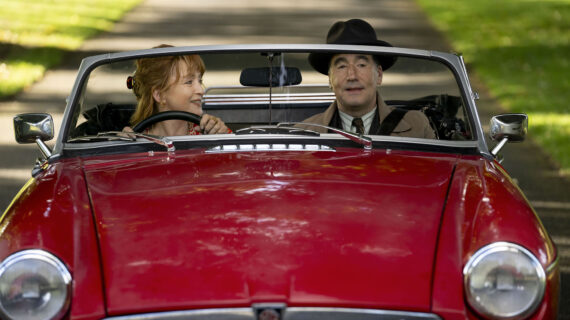– Welcome everyone to Wednesday Nite @ the Lab. I’m Tom Zinnen. I work at the UW-Madison Biotechnology Center. I also work for the Division of Extension, Wisconsin 4-H. And on behalf of those folks and our other co-organizers, PBS Wisconsin, the Wisconsin Alumni Association, and the UW-Madison Science Alliance, thanks again for coming to Wednesday Nite @ the Lab. We do this every Wednesday night, 50 times a year. Tonight, it’s my pleasure to introduce to you Julie Poehlmann. She’s a professor here in the School of Human Ecology, and she is a child clinical psychologist. She got her undergraduate degrees from Marquette University in psychology and history, and then she got her master’s and her PhD in clinical psychology at Syracuse University in New York. She also did a postdoc at the Waisman Center here at UW-Madison. Tonight, she’s gonna speak with us about children with incarcerated parents. Would you please join me in welcoming Julie Poehlmann to Wednesday Nite @ the Lab?
– Thanks so much for that introduction, Tom. I’m really pleased to be here talking with you today about children with incarcerated parents and hopefully, it’s information that maybe you don’t know of or that you’re interested in hearing more about. So I’ll give you an overview of the number of parents and children who are affected by parental incarceration. And then I’ll tell you a bit about my research and I’ll talk about the impact of parental incarceration on children, what happens when children witness their parents’ arrest, and then how we can support positive parent-child interactions during their parents’ incarceration. So unfortunately, the U. S. is the country that incarcerates the most people in the entire world. So they not only incarcerate the most people, but also the highest rate of incarceration is in the United States. And this is true for countries that are developed and also ones that are developing.
Now, if you look at that over time, back in the early 1920s when the U. S. started keeping track of who is incarcerated in the United States, you can see that there was a really low level of incarceration all the way through about 1980s. And then there was skyrocketing rate of incarceration. And now we’re in this period that we call mass incarceration. And even though the rate of incarceration has leveled off a little bit and even decreased among men since about 2013, it’s still very high, and the rate of women who are incarcerated has continued to climb very quickly. There are also really large disparities in who is incarcerated in the United States, with Black and Latinx folks incarcerated at much higher rates, but especially Black individuals are incarcerated at many times the rate of white individuals in our country. And unfortunately, Wisconsin is the worst in this disparity. So there’s a lot more that can be done to improve that. Another thing to keep in mind is that there are differences in where people are incarcerated in the United States.
It could be state prison, federal prison, or local jails. And this graph shows that any point in time in a year, there are about a little more than a million people incarcerated in state prisons across the United States. And about 200,000 are incarcerated in federal prison and jails, and about 500,000 are incarcerated in local jails. But this snapshot in time doesn’t tell the whole story. Really, most incarceration is occurring in local jails with 9 million or even 10 million people admitted to jails across the U. S. each year. And this can be particularly concerning when we’re talking about parents who are incarcerated because children are most likely to experience the incarceration of a parent in jail. In this graph, you can see that there are a number of reasons that people are held in jails. About 60% are held before they are convicted or before they are sentenced.
So they might be held in jail for up to a year even for various reasons. And that means that they’re separated from their families for more time even before they’re convicted or sentenced. Incarceration in the United States has become such a problem that a recent nationally representative survey found that one in two adults in our country has a close family member who has been incarcerated in jail or prison. That’s shocking. It’s actually a crisis. About half of incarcerated individuals are parents of minor children. So for women in state and federal prison, about 58% report that they are mothers of minor children, but in jails, about 80% report that they are mothers of minor children. Now, for men that’s a little bit less, with about 47% of men in state and federal prison reporting that they’re parents of minor children with, again, higher rates reported in jails. So that means a lot of children are affected during this period of mass incarceration in the United States. So we know that from a recent survey that was nationally representative that about 1 in 14 U.S. children are affected by having a resident parent leave for jail or prison. And again, disparities exist in children’s experiences of parental incarceration. So one in eight poor children and one in nine Black children are experiencing resident parent leaving. Now there are also non-resident parents who are involved in their kids’ lives who also go to jail or prison. And so the total figure is that 10 million children in the U.S. have experienced parental incarceration in their lifetime, if you include the kids who have a non-resident parent incarcerated. So now that I’ve gone over some of the scope of the problem in the United States, I’d like to now move on to talking about the impact of parental incarceration on minor children. And here you can see that there is a continuum of the different kinds of research that’s been done focusing on this.
And it’s all the way from kids who’ve experienced their parents, who have been arrested or stopped by the police all the way over to reintegration or reunification following incarceration. So think of this as a continuum of parental criminal legal involvement and how it might affect kids. Now in red is what most people are studying in this area, and that is kids who have a parent who’s incarcerated in prison or jail or who have ever experienced a parent incarcerated in prison or jail. But there are a lot of other things that we could study as well. So on this slide in the big bubbles toward the bottom are the kinds of things that I’ve been studying, the ones in red. So for example, did children witness their parents’ arrest? Who cared for children when a parent is arrested? And then while parents are incarcerated, what kind of communication do the families have? How do families talk to kids about the parent’s incarceration, and what is the quality of their caregiving environments and co-parenting, et cetera? And then also recently I’ve done some research focusing on plans for family reunification and then how does parent-child communication and visiting relate to recidivism and reintegration into the community? In addition to that continuum of the types of research that can be done when focusing on children with incarcerated parents, it’s also really important to keep in mind the child’s perspective on this. And a group in San Francisco that included youth whose parents were incarcerated came up with some rights that they feel that people should consider when studying or intervening with children whose parents are incarcerated. And so I think it’s important to keep these things in mind as we have this conversation. And also when I tell you about my research, I keep these things in mind. So, the youth who were affected by parental incarceration felt that they had the right to be kept safe and informed at the time of their parents’ arrest, to be heard when decisions are made about them, to be considered when decisions are made about the parent, to be well cared for in the parent’s absence, to speak with, see, and touch their parent, to support as they face their parents’ incarceration, not to be judged, blamed, labeled, or stigmatized, and to a lifelong relationship with the parent.
And so I hope that you can keep all these points in mind as you hear the next part of the presentation, which focuses on the potential impact of parental incarceration on children. So my colleague at University of California Irvine, Kristin Turney and I recently did a review of the literature focusing on children with incarcerated parents. And we wanted to take a developmental perspective, that is look to see if there are any differences in findings based on children’s age or developmental capacities. And so in general, we found that a number of things are more likely for children with incarcerated parents compared to their peers, even controlling for a whole host of factors that are considered selection factors, if you will, or things that might have occurred in a child’s life even prior to a parent’s incarceration. So even controlling for those kind of things like demographic factors, we found that the things that are more common in children with incarcerated parents include sadly infant mortality. Also behavior problems, both the acting out or externalizing behavior problems and the more internalizing or withdrawn, anxious, depressed kinds of behavior problems. Other kinds of things that are more common among children with incarcerated parents include health problems, problematic academic outcomes, poor mental and physical health, even into adulthood, and experiencing more adversity during childhood. We also documented how parental incarceration can really throw a long shadow across child and family life. So even if it doesn’t cause certain problems, it can exacerbate problems that already exist. This includes things like residential instability and even homelessness for children, socioeconomic disadvantage, including the fallout of that, which is often dependence on public assistance and unemployment for the family, in addition to mental health concerns among the adults, family conflict, diminished co-parenting, and relationship dissolution and re-partnering.
And as I mentioned, parental incarceration sometimes causes those problems, but even if it doesn’t cause the problems, it can make them worse. So the additional findings of the review included documenting that there are worse outcomes when a parent’s incarceration occurs earlier in a child’s life. There are also worse outcomes documented as children get older, such as during adolescence and young adulthood. And when you take both of those things together, those are called age-graded effects, or the effects depend on the age of the child at the time that incarceration occurs, but also at the time that we’re measuring the outcomes. And one could ask, “Why?” Why do the younger children have more problems, but especially as they get older? And this could be because of a number of issues. It could be because of continued stressors that the children are experiencing over time, and it could relate to stress-related changes in the body and the brain, which continue into development. It could also be the types of measures used in adolescence and young adulthood across these studies because they might be measures that pick up changes that occur in adolescence and young adulthood. But it also could be related to cascades of risk that might be happening or diminishing protective factors. That is, if an incarceration occurs early in a child’s life, the child might also be likely to experience additional parental incarcerations over time, which could lead to the accumulation of risk factors. Additional work needs to be done to examine why we found these things.
So, one of the things that I’ve been looking at since that time is the effect of stress in children with incarcerated parents. And in general, we know that stress processes can occur for a number of different reasons. The experience of stress is normal for everybody. Everyone experiences some degree of stress, but some children unfortunately experience really high levels of stress. And some of the things that children with incarcerated parents might experience include stressful things like living in poverty, housing instability or homelessness, shifts in caregivers, exposure to violence, and other adverse childhood experiences. And they might also, in addition to those general factors, they may experience factors that are kind of specific to having an incarcerated parent, like witnessing a parent’s arrest or the stigma or secrecy around the parent’s incarceration. They also oftentimes visit in corrections environments. They may experience repeated bouts of parental absence, and then that may also be related to parental recidivism or when a parent serves their time, comes back out in the community, lives with or is in communication with the child and then has to go back in later on. And that can take its toll on children. So all of these things might be related to stress.
In addition, I had mentioned that children with incarcerated parents, especially when they’re young, are more likely to experience other adversities. So parental incarceration or having someone in your household incarcerated while you’re young is an example of an adverse childhood experience or sometimes it’s called an ACE. And listed here are the original 10 ACEs that were identified decades ago. And these include things like physical, emotional, and sexual abuse, neglect, various forms of household dysfunction including parental mental illness or substance abuse or domestic violence. And these kinds of things have been shown to have negative implications as a person gets older. So in the original work, looking at adults who reported about adversity in their childhood, it was found that when the adults had four or more adverse childhood experiences, they were more likely to have certain diseases and early mortality. And right now, we don’t know exactly why this occurs, but again, we think that it’s possibly related to stress. So some of the outcomes that are associated with having more ACEs in one’s childhood include things like lack of physical activity, smoking, alcoholism, drug use and missed work, and also health conditions such as obesity, diabetes, depression, suicide attempts, heart disease, stroke, and cancer. So these are all things that are related to the accumulation of childhood adversity. And as I mentioned, one of the things that we think might be underlying this association between more adversity during childhood and later, problematic health behavior and mental health outcomes has to do with stress.
So when someone experiences just normal stress in life, they have certain reactions like their heart rate increases, they might perspire, they get a dry mouth, digestion slows down, their pupils dilate. It’s basically the body getting ready to act. And this might include things like a flight reaction, a fight reaction, a freezing reaction, or trying to seek out support or a befriending reaction. Now in kids, what can happen is that when stressors really, really pile up and kids are reacting to that, if they don’t get adequate supports or if the stressors really continue at a high level, they experience what’s called toxic stress. And that’s when there’s really high levels of stress hormones going through the body that can really affect their cognition, their growth, their health, their sleep. It can affect so many different things. Now, if this keeps happening over a long period of time, their body can even just kind of shut down in the stress reactions that they’re having. So they don’t even have normal stress reactions anymore. So one of the things that my team examined was if we could see these kinds of stress reactions in children with incarcerated parents. So we studied kids who were young, age two to six years old, and their parents were incarcerated in jail.
And we looked at the stress hormones in the kids and whether or not it was related to the child witnessing the parent’s arrest, which can be a particularly stressful and even traumatic experience. Previous research has shown that about 20% to 40% of children with incarcerated parents have witnessed their parents’ arrest. So, because of this, a number of protections have been developed or protocols for safeguarding children during parental arrest. So, when police officers and other law enforcement officials engage in these practices to protect children, we know that the traumatic effect of witnessing a parent’s arrest can be minimized. However, what we did is we studied kids in areas where they did not have these protections in place. And so we did a kind of interesting design where we did a home visit during a parent’s incarceration, which you can see on the bottom right of this graph. And then we asked both the incarcerated parents and the children’s caregivers to report about what had been happening prior to that. So it’s kind of like a retrospective longitudinal design. And so we heard from both parents and caregivers whether or not the child had witnessed the parent’s arrest or they had witnessed the parent’s crime and then how they reacted to it. We also had them report about children’s stress symptoms during the past several months.
And then we measured stress hormones called cortisol and cortisone, and we measured those through taking a sample of children’s scalp hair. And what we did was we were able to look at the accumulation of those stress hormones over the past several months so that then we could determine what kinds of experiences were correlated with children having higher levels of stress hormones in this sample of young kids whose parents were incarcerated. So in this study with children who were young, age two to six, we found that when the kids witness their parents’ arrest, they overall showed higher levels of stress hormones, even controlling for a variety of demographic factors and whether or not they had witnessed the parents’ criminal activities, which also could be stressful. But the most concerning thing was that the kids who had already been showing some behavioral stress symptoms and witnessed their parents’ arrest were showing the most physiological stress. And it was so bad for these kids that they were showing something called a blunted stress reaction. That is that they had been experiencing stress for such a prolonged period of time that their body was no longer responding in the normal way with that influx of stress hormones. In fact, sometimes the cortisol and cortisone were even at undetectable levels, even though we repeated the analyses numerous times. So that’s really concerning, and a sign that witnessing the parent’s arrest could have been really traumatic for some of these kids. And again, remember that this was in places that protocols for safeguarding children with incarcerated parents and arrested parents had not been put into place. And so the law enforcement officers were not engaging in practices that were recommended for protecting children.
To further explore this issue, we collected data on a sample of slightly older kids. They were aged three to eight, and we looked at whether or not witnessing a parent’s arrest was related to their health and development. And so in this particular study, we didn’t measure physiological stress, but we measured some of the kinds of things that you might see if stress is happening for a long time in young children. And so once again, we had a longitudinal design. Part of it was retrospective, where we asked families who currently had an incarcerated parent to report about whether or not the child had witnessed the parent’s arrest. And then we also in this particular study could measure whether or not the children had witnessed other violence in the home so we could control for that. And then we looked at kids’ emotional symptoms over time, and those are kind of stress-related symptoms as well. And then we did a developmental screening of kids as they entered a jail before they visited one of their parents who was incarcerated. And we also asked children’s caregivers to report on their health and development over time. So we found that the children with the least optimal health and development were the kids who had witnessed the parent’s arrest in addition to showing ongoing emotional stress symptoms.
And so you can see in this graph, the line with the blue dots means that the child did not witness the parent’s arrest. The line with the red dots were the kids that witnessed the parent’s arrest, but they were only moderately distressed by it. And the green dot line means that the child witnessed the parent’s arrest and they were extremely distressed about it. And so you can see on the bottom right, that lowest dot shows that the kids with the highest emotional stress symptoms who had witnessed their parent’s arrest and showed a lot of distress about it were also the kids that were reported to have the least optimal health. And this was also replicated with other outcomes like early literacy and numeracy, other developmental milestones, and then health at later time points. And again, this was controlling for whether or not the child had witnessed violence in the home. And again, it was in areas where law enforcement systems had not implemented model policies regarding safeguarding children of arrested parents. So there are things that we can do to help these kids who have been really traumatized by witnessing their parent’s arrest. And these include things like conducting the arrest out of earshot and eyeshot of the children, having law enforcement officers talk directly to children in a developmentally appropriate way, giving parents a chance to say goodbye, not using force, and making sure the kids are well-cared for when the parent is taken away. There are protocols that you can find online that describe these procedures and there are webinars that law enforcement systems can sign up for, for trainings to implement these model policies that were created by the Bureau of Justice Assistance and the International Association of Chiefs of Police.
And I would highly recommend that if you live in an area that doesn’t have them, that you advocate for safeguarding children. Because whatever a parent is doing, it’s never the kid’s fault. One of the things that hadn’t been done before is looking at how many kids experience their parent’s arrest, not just witness it once their parents were arrested and incarcerated, but in the general population. And so a couple of colleagues, Elizabeth Johnson at the University of Tennessee and Elizabeth Planalp at University of Wisconsin and I worked on analyzing some nationally representative data of 9 and 10-year-olds to look at parental arrest. And what we found is that using data from the adolescent brain and cognitive development study, which includes more than 11,000 youth who are aged 9 to 10 who were followed yearly for 10 years, is that 12. 5% of the youth had a parent who had been arrested for an issue related to drugs or alcohol. That’s a really high proportion of youth. And that doesn’t even include parental arrests for other reasons. But importantly, even when we controlled for a number of other risk factors, we found that youth who had experienced parental arrest showed higher levels of both internalizing and externalizing behavior, especially when their mother had been arrested. And so it’s important to note that it doesn’t even have to be when a child witnesses the parent’s arrest; we still find effects when their parent has been arrested for drug or alcohol issues.
So on that continuum that we looked at, at the beginning where you could see what are the effects of parental incarceration on children, but also other forms of parental legal system involvement, you can see that even having a parent arrested, whether or not they’re incarcerated, might have an impact on children. So we know that each police encounter has the potential to remove a person from their family and for parents from their children. And again, racial disparities in arrests are really common. So in 2016, 27% of all individuals arrested in the U. S. were Black, which is double the rate that you would expect based on the U. S. population. And we also know that disparities exist in the outcomes of police stops. Once pulled over, Black and Latinx drivers are three times as likely as white drivers to be searched, and Black drivers are twice as likely to be arrested, which definitely can affect children if that individual is a parent.
Black and Latinx drivers are also more likely to experience some use of force in their interactions with police. So it’s important to keep in mind that there are racial disparities in not just in parental incarceration as we talked about before, but also in arrest and thus in children who have arrested parents. So now I’ll move on to talking about supporting positive parent-child interactions during parental incarceration and tell you a little bit about a few projects I’ve been working on in the past number of years. And they’re all collaborative projects. One involves a Sesame Street intervention with kids aged three to eight. Another one involves a child-friendly visit program evaluation. And the third one involves enhancing visits in jail through use of digital technology, which has been particularly important during the pandemic. So one of the reasons that we want to focus on parent-child contact during parental incarceration is it has importance for both parents and kids. For parents, more parent-child contact during parental incarceration is related to fewer rule-breaking instances inside prisons, fewer symptoms of depression, more engaged relationships with children, and lower recidivism following release. After incarceration, when there is more parent-child contact, the parents who receive more contact have more positive parenting activities such as playing with children, helping with homework and discipline, fewer symptoms of depression, more hours of work, fewer correctional supervision violations, and less engagement in criminal activities.
And so these are really important outcomes, not only for the incarcerated individual or formerly incarcerated individual, but also for their family and for society. Now for kids, there’s a number of things that we like to consider when we’re thinking about how we can facilitate positive contact during parental incarceration. So with a caveat here, you know, it’s true that not every single kid wants to or should have contact with their incarcerated parent, but for the vast majority of incarcerated parents and their affected children, it’s appropriate. But it really needs to be determined on a case by case basis. But in general, we know that for kids, child-friendly visits are best. And I’ll talk a little bit more about what a child-friendly visit entails in a couple of minutes. It’s also important to support remote video visits. They can be a really good supplement to in-person visits, especially when a family doesn’t have access to transportation to come to the jail or prison or they don’t have time or they’re not allowed to visit because of issues like the pandemic. It’s really important to give families choice over the kinds of visits and communication that they have with an incarcerated family. And the cost is really important because our recent study found that kids from lower income families received less visits and phone calls with their incarcerated parents than other kids.
And it really shouldn’t just depend on a family’s income, especially when all these positive benefits can accrue to individuals, families, and society when there’s more contact. Another consideration for young children is that plexiglass visits or visits behind glass can be pretty stressful because kids don’t understand why they can’t touch the parent and they can only hear the parent through an old-fashioned telephone device, which is really hard for kids because most kids these days haven’t experienced anything except cell phones in their lifetime. There’s also sometimes waiting periods before being able to visit an incarcerated parent. And especially for young children, that can be really hard and they can kind of even melt down even before they have a visit just because of really long wait times. And interactions with correctional staff are really important when a family comes in to visit with an incarcerated parent. And so there are opportunities for training and working with correctional staff to help them interact with children in positive ways, even when they have to follow their security procedures. So the first kind of intervention that I worked on to facilitate positive parent-child interaction during parental incarceration was with Sesame Street, and their initiative called “Little Kids, Big Challenges: Incarceration” was designed to support young children and their families when a parent was incarcerated. And the target age for the intervention is about three to eight, although kids who are even younger or older could potentially benefit. And the resources include a number of different materials. So it’s a multimedia intervention that’s available in both English and Spanish, and it’s available for free in the app store or online.
The videos are available on YouTube. There’s lots of places that they can be accessed. And it includes a book for little kids about a day when a child goes to school for a family day. And because the parent’s incarcerated, they bring an uncle with them to school. There are also videos. There’s a character, a Muppet character named Alex that was developed for the project, and he has an incarcerated dad, and there are videos of him expressing his feelings, expressing how he worries, expressing how he’s sometimes been stigmatized or bullied, and then showing other Muppets and humans supporting him and helping him work through his feelings. There’s also a caregiver guide, which describes how caregivers can talk to children about their parents’ incarceration, even when kids are really young, which can be helpful for kids to understand where their parent is and when they might be home again. So this is a screenshot of the website. It’s sesamestreetincommunities. org/ topics/incarceration and it includes activities that people can do with kids, shows how they can stay in touch with their families during a parent’s incarceration, and lots of materials for families and professionals working with families.
So here are some of the videos, and I would encourage you to watch these ’cause they’re really sweet. There’s Alex talking about what is incarceration. There’s an animated video of a child visiting their parent who’s in prison, and there’s the book In My Family, in addition to a beautiful song that’s called “You’re Not Alone. ” And it really helps kids get the message that they’re loved, even if they have a parent who’s incarcerated. So I also feel comfortable recommending these materials because my team did some evaluation research. We did a really rigorous study called a randomized control trial, which means that we randomly assigned families with kids age three to eight who had an incarcerated parent to either receive the educational materials or to be on a wait list control group where they got the materials, but at a later time. And then we did a number of things, like observe kids coming in to visit with their incarcerated parents. We also did interviews with the children’s caregivers over time, and one of the most important things that we found is that caregivers in the Sesame Street Intervention Group reported more positive change in how they talked to children about the parents’ incarceration over time compared to the control group. Now, a lot of caregivers engage in something called compassionate deception, or they make up a story about where the incarcerated parent is so they can spare children from the pain of stigma should other people find out. However, if kids are told things like the parent’s away at work or in the military or just doing something else, in college or in a hospital, kids often wonder why they can’t go visit them or why the parent doesn’t come back.
And sometimes it leads to kids becoming more stressed and anxious, whereas if they’re told a very simple, developmentally appropriate statement about where the parent is, it can be reassuring. And then they know that they can talk to their caregivers about their parent and if they have feelings about it, and then they can be given information about when the parent might be coming home and how they can keep in contact with that parent. So that’s important. We also found that children who were told the simple, honest truth about the parent’s incarceration, which is a recommendation in the Sesame Street materials, those kids exhibited more positive affect during their visit with their incarcerated parent. So that was the Sesame Street intervention, focusing on supporting positive parent-child contact. Another one that I have been working on involves a formative program evaluation of child-friendly visits. And this was done by Camp Reunite, which is run by Hometown Heroes Incorporated, which is a group in Wisconsin that facilitates camps for children who’ve experienced different forms of loss. They started with kids who had lost a parent because of military service, and then they expanded to focus on other issues, like having an incarcerated parent. And it was a really unique camp because for a week, kids went there and did normal camp things. They spent a lot of time outside, they had camp activities, but during the camp, they also had child-friendly visits with their moms who were incarcerated at Taycheedah, which is one of the main prisons for women in Wisconsin.
And so I helped do the program evaluation, and what we found is that overall, the child-friendly visits were viewed positively by everyone, by the mothers, the kids, the children’s at-home caregivers, corrections and camp staff, and corrections and camp administrators. And child-friendly visits really just means that kids are able to interact with their incarcerated parents doing things that they might do on the outside, like engaging in developmentally appropriate activities like crafts or games or reading or puzzles or art activities. And then they also might be able to have a meal together or snacks and they get to have physical contact. So at a normal visit that occurs in a prison, they might have to sit at a table and only hold hands, or not even hold hands, just have a hug at the beginning and the end, but no other contact. In a child-friendly visit, the kids can give lots of hugs, the parents can carry the kids around or you know, the kids can sit on their laps, et cetera. And then there are usually some modified security procedures that mean kids don’t have to be searched as extensively as they might for a typical visit. And then in child-friendly visits, oftentimes it’s just the kid and the parent. So the child’s caregiver usually isn’t present for those. And so it’s just more direct communication between the kid and the parent. We did find that saying goodbye after these two long, child-friendly visits that occurred during the camp was hard.
And what helped was providing some structure, giving kids transitional objects, giving both the mom and the child photos of them together. And then therapeutic activities like drawing, painting, using clay, having therapy dogs and extra support from staff really made a difference in children’s experience of these visits. And here’s a photo of just what the visits look like, where kids were interacting with their moms, sitting close by them, eating together, doing things together. They could even run outside together, which was great. So the third intervention that I’ve worked on in the recent past to facilitate positive parent-child interaction during parental incarceration is a collaboration with a number of investigators from University of Wisconsin-Madison, including Paja Charles, Maggie Kerr, and Mike Massoglia. And we started this before the pandemic and wanted to facilitate positive interactions using digital technology. So we know that many places have moved toward allowing video visits between incarcerated parents and their children, and this could be in a facility or it could be remote in a home setting. And what we wanted to look at is if we helped families with the technology piece and with some support and coaching, if that could lead to really more positive outcomes in kids and families over time. And so what we did in the intervention, which we call the enhanced visits model, is we provided families with smart tablets, internet access if they didn’t have it, and free video chat usage to connect to the jail. We also provided adults with pre- and post-visit coaching so that they could really focus on the child’s experience of the visit and how to support that.
And we looked at both short-term and we’re in the process of looking at longer term outcomes. But really so far, we’ve found that there has been an increase in opportunities for family contact and frequency of family communication for the families who participated in the enhanced visit model. And we’re also looking at if there are long-term outcomes like improved child behavior, attachment, and even lower recidivism in the incarcerated individuals. So here’s a picture of what a plexiglass visit looks like. And for kids, this can be really stressful, as I mentioned before, because they don’t understand why they can’t touch the parent through the glass and they often spend a lot of time watching other visits. So before this intervention, we had done a series of studies where we actually observed kids during their visits and we found that they spent more than half their time looking at other visits and not interacting with the incarcerated parent. They also became kind of stressed because of the glass. There also video visits that are done in a facility, and they often look like this. And again, kids were spending a lot of time watching the other video monitors instead of focusing on their incarcerated parent. And again, they couldn’t hear very well because they had to have their ear pressed up to the handheld telephone device.
And so this was hard for kids as well. So we wanted to support what’s called remote video visits. That is video visits where kids could connect with their incarcerated parent from the comfort of their own home where they could just be relaxed and hang out, not have to go through security and talk. And so this is what it looks like from the end of the incarcerated parent having that video visit. And one of the things that we found is that during these video visits that occurred while kids were in their homes, is that kids often did things that they couldn’t do in a corrections facility. Like they showed their incarcerated parent their room or their toys they got for their birthday, or they ate dinner with the incarcerated parent there, or the incarcerated parent played a game with them or played with their dolls with them and sang them a lullaby at night or helped direct them brush their teeth, helped decorate the Christmas tree or even attended a birthday party. So they really could do things that they wouldn’t have been able to do if they had visited in the corrections facility. So the way that the kids were interacting with their incarcerated parents during these remote-supported video visits were really positive and were more typical for what kids experienced during family life or even other remote communications that might have increased during the pandemic, such as FaceTiming or Skyping or Zooming with relatives who didn’t live with them. So from the kids’ perspective, it felt like really comfortable. From the adults’ perspective, they thought it was helpful, although there were some technology glitches, and oftentimes these visits can be expensive.
And so in this particular project we paid for the visits, but we would advocate that the visits should be free or very low cost to give more families access to them. We also think it’s important to give families a choice. Remote video visits are not for everybody. They can be a really great supplement to other kinds of visiting and other forms of communication, but I don’t think they should be the only way that families are able to visit. Another form of positive parent-child contact can come in the form of letters, and letters can be something for a kid to hold onto. They can save them and they can take them out when they want to. Now for young children, they need a lot of support because obviously they can’t read or write, and so they need a caregiver in their lives to help them with that. Or they can also draw pictures and receive pictures, and that can be important as well. I have permission to share with you a letter from a girl whose mom was incarcerated, and I think that you can see here how important the letters are for this girl. The letter says, “Dear Mom, thank you for the letters you recently sent me. I needed to hear everything you wrote me in both of those letters. Yes, I got better with my sadness and yes, I’ve been better and happy, but man, I miss you so much. Not having you here hurts me so much more than you could even imagine. I feel happy and stuff, but then at the end of the day, tears just come out thinking of you. So I get frustrated and I get a stupid attitude, or I just get other people around me mad and then I get in trouble and I just start to hate everything. You being here is the only thing I need.” So you can just see how the things that someone might be able to express in a letter are potentially a little bit different than they might be expressing in a phone call or in an in-person visit. Now, telephone calls can be really helpful and they’re actually the most common way for parents and children to communicate during parental incarceration. But for little kids, telephone calls aren’t the greatest. They actually spend a lot of time just, you know, looking around and even just breathing into the phone call.
And so that can be really challenging for younger kids, but there are lots of ways to support letter writing and also it can help with literacy. And so a number of literacy programs for children and their incarcerated parents have sprung up across the U. S. in the last decade. There are some examples, even in Wisconsin. For example, the Literacy Link, which is run by University of Wisconsin Extension, is providing ways for incarcerated parents and their children to connect with each other with a basis in literacy and book reading. There’s also a link here about how to start a literacy program for children with incarcerated parents if you are interested in doing that in your own community. There are also a number of parenting interventions for families with incarcerated parents, which can be helpful to facilitate positive parent-child connections. And some of these programs have been designed and evaluated with incarcerated parents and their families. And the best example of that is Parenting Inside Out, which is offered in a number of facilities in Wisconsin and around the country.
And it has been evaluated rigorously using a randomized controlled child design. There are also a number of parenting programs that they may have been designed and evaluated for other vulnerable children and then tried with children whose parents are involved in the criminal legal system and they could be, you know, positive for kids with incarcerated parents. And this includes the Circle of Security intervention and the Strengthening Families Program. And some additional ones could be tried, like the Mediational Intervention for Sensitizing Caregivers or the MISC program; that’s being used in Texas right now with moms who have been released from corrections facilities. And then the Attachment of Biobehavioral Catchup program that’s been used with kids who are in foster care. So, one of the things that I like talking with the different audiences I encounter involve exploring the connections of this work with your work and life. And so I would ask you to reflect on the kinds of experiences you have with children or families affected by the criminal legal system or the justice system. And are there any things that you might like to do in the future regarding affected kids and families, either from the ideas presented here or from other sources, things that might help your community or families or individuals and help make their lives better? There are mentoring programs that people can be part of. There are many programs that are done in faith-based communities or in schools that you could potentially become involved with. And what is one thing that you can try starting this week or next week regarding affected families and children, even if it’s trying to reduce stigma and how you talk about affected families and kids.
If you’re interested in finding out more information, here are a few volumes that I’ve worked on, focusing on children with incarcerated parents. One is a handbook and it focuses on research policy and practice and provides a really good summary of the literature. The other is a monograph, and that’s called Children’s Contact with Incarcerated Parents, and focuses on a number of different ways that kids and their families connect with each other during incarceration. And the newest one is a book called When Are You Coming Home? How Young Children Cope When Parents Go To Jail. And it really focuses on the kids’ perspective when their parents are incarcerated. And it gives case examples of five or six families that have been experiencing this and how they are resilient or do well despite experiencing the challenges of having a parent incarcerated. I also have a blog. It’s www. kidswithincarcerated parents. com where I translate the research that’s being done into plain language that’s accessible for families and for practitioners, policy makers, et cetera.
And so you can subscribe to that by going and clicking on the button to get an email if there’s anything new that’s posted on the blog. And this can be helpful for people who don’t have time or don’t wanna read long journal articles or entire books. And I just want to say thank you. I’m really indebted to those with lived experience who have shared their stories with me for the past 25 years. I really do this research in honor of the families and kids who are affected and I try to represent their stories and amplify their voices in my work. And thank you to my students, both the undergraduate and graduate students, post-doctoral fellows and collaborators in Wisconsin and all around the country for their hard work and perseverance on this sometimes challenging topic. And thank you to PBS for hosting educational opportunities like this. And thank you to my audience for watching and listening. I really hope that you’ve learned something valuable and it’s been a pleasure talking with you. Thank you.
Search University Place Episodes
Related Stories from PBS Wisconsin's Blog

Donate to sign up. Activate and sign in to Passport. It's that easy to help PBS Wisconsin serve your community through media that educates, inspires, and entertains.
Make your membership gift today
Only for new users: Activate Passport using your code or email address
Already a member?
Look up my account
Need some help? Go to FAQ or visit PBS Passport Help
Need help accessing PBS Wisconsin anywhere?

Online Access | Platform & Device Access | Cable or Satellite Access | Over-The-Air Access
Visit Access Guide
Need help accessing PBS Wisconsin anywhere?

Visit Our
Live TV Access Guide
Online AccessPlatform & Device Access
Cable or Satellite Access
Over-The-Air Access
Visit Access Guide
 Passport
Passport

















Follow Us